National Gallery of Canada
|
| |
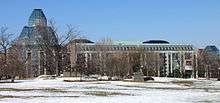 | |
| Established | 1880 |
|---|---|
| Location |
380 Sussex Drive Ottawa, Ontario K1N 9N4 |
| Coordinates | 45°25′46″N 75°41′54″W / 45.429434°N 75.698386°WCoordinates: 45°25′46″N 75°41′54″W / 45.429434°N 75.698386°W |
| Type | Art museum |
| Director | Marc Mayer |
| Curator | Paul Lang |
| Public transit access |
|
| Website |
www |
The National Gallery of Canada (French: Musée des beaux-arts du Canada), located in the capital city of Ottawa, Ontario, is Canada's premier art gallery.[1]
The Gallery is now housed in a glass and granite building on Sussex Drive with a notable view of the Canadian Parliament buildings on Parliament Hill. The building was designed by Moshe Safdie and opened in 1988.[2] The Gallery's former director, Jean Sutherland Boggs, was chosen especially by Prime Minister Pierre Trudeau to oversee construction of the national gallery and museums.[3]
Marc Mayer was named the museum's director, succeeding Pierre Théberge, on 19 January 2009.[4]
History
.jpg)
The Gallery was first formed in 1880 by Canada's Governor General, John Campbell, 9th Duke of Argyll, and, in 1882, moved into its first home on Parliament Hill in the same building as the Supreme Court.[2] In 1911, the Gallery moved to the Victoria Memorial Museum, now the home of the Canadian Museum of Nature. In 1913, the first National Gallery Act was passed, outlining the Gallery's mandate and resources.[2]
In 1962, the Gallery moved to the Lorne Building site, a rather nondescript office building on Elgin Street.[5] Adjacent to the British High Commission, the building has since been demolished for a 17-storey office building that is to house the Federal Finance Department. The museum moved into its current building on Sussex Drive in 1988, beside Nepean Point.
In 1985, the newly created Canadian Museum of Contemporary Photography (CMCP), formerly the Stills Photography Division of the National Film Board of Canada, was affiliated to the National Gallery. The CMCP's mandate, collection and staff moved to its new location in 1992, at 1 Rideau Canal, next to the Château Laurier. In 1998, the CMCP's administration was amalgamated to that of the National Gallery's.
In 2000, the Royal Architectural Institute of Canada chose the National Gallery as one of the top 500 buildings produced in Canada during the last millennium.[6]
Directors
|
|
Collection
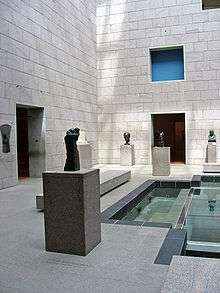
The Gallery has a large and varied collection of paintings, drawings, sculpture and photographs. Although its focus is on Canadian art, it holds works by many noted American and European artists. It has a strong contemporary art collection with some of Andy Warhol's most famous works.[7] In 1990 the Gallery bought Barnett Newman's Voice of Fire for $1.8 million, igniting a storm of controversy. Since that time its value has appreciated sharply. In 2005, the Gallery acquired a painting by Italian Renaissance painter Francesco Salviati for $4.5 million.[8] Its most famous painting is likely The Death of General Wolfe by Anglo-American artist Benjamin West.
In 2005, a sculpture of a giant spider, Louise Bourgeois's Maman, was installed in the plaza in front of the Gallery.[9] In 2011 the gallery installed Canadian sculptor Joe Fafard's Running Horses next to the Sussex Drive entrance, and American artist Roxy Paine's stainless steel sculpture One Hundred Foot Line in Nepean Point behind the gallery.
The Canadian collection, the most comprehensive in Canada, holds works by Louis-Philippe Hébert, Tom Thomson, the Group of Seven, Emily Carr, Alex Colville, Jean-Paul Riopelle and Jack Bush.[10]
The Gallery organizes its own exhibits which travel across Canada and beyond, and hosts shows from around the world, often co-sponsored with other national art galleries and museums.[11][12]
The Gallery's collection has been built up through purchase and donations. Much of the collection was donated, notably the British paintings donated by former Governor General Vincent Massey and that of the Southam family.
Selected works
The museum features Canadian, Native and Inuit art, American and European painting, sculpture, prints and drawings, modern and contemporary art and photographs. The largest work in the Gallery is the entire interior of the Rideau Street Chapel, which formed part of the Convent of Our Lady Sacred Heart,[5] The interior decorations of the Rideau Street Chapel were designed by Georges Couillon in 1887. After the convent was demolished in 1972, the chapel was dismantled, stored and reconstructed within the gallery as a work of art in 1988.
Renaissance and Mannerism
 Hieronymus Bosch, The Temptation of St. Anthony, 1501–50.
Hieronymus Bosch, The Temptation of St. Anthony, 1501–50.- Hans Baldung, Eve, the Serpent, and Death, c. 1510–15.
%2C_Daniele_Barbaro%2C_1545._National_Gallery_of_Canada.jpg) Titian, Daniele Barbaro, 1545.
Titian, Daniele Barbaro, 1545.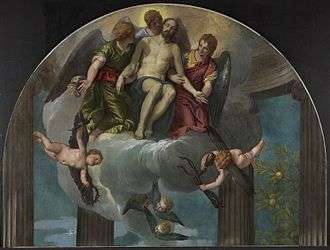
 El Greco, St. Francis and Brother Leo Meditating on Death, c. 1600–05.
El Greco, St. Francis and Brother Leo Meditating on Death, c. 1600–05.
Baroque
 Peter Paul Rubens, The Entombment, c. 1612–15.
Peter Paul Rubens, The Entombment, c. 1612–15. Rembrandt, Heroine from the Old Testament, 1632–33.
Rembrandt, Heroine from the Old Testament, 1632–33.
Romanticism, early 19th century
 Benjamin West, Death of General Wolfe, 1770.
Benjamin West, Death of General Wolfe, 1770. Caspar David Friedrich, Boy Sleeping on a Grave, c. 1801–03.
Caspar David Friedrich, Boy Sleeping on a Grave, c. 1801–03.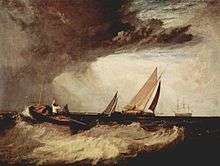 J. M. W. Turner, Shoeburyness Fishermen Hailing a Whitstable Hoy, c. 1809.
J. M. W. Turner, Shoeburyness Fishermen Hailing a Whitstable Hoy, c. 1809. Eugène Delacroix, The Barque of Dante, c. 1820.
Eugène Delacroix, The Barque of Dante, c. 1820. Francisco Goya, Holy Week in Spain in Times Past, c. 1825.
Francisco Goya, Holy Week in Spain in Times Past, c. 1825.
19th century, Post-Impressionism
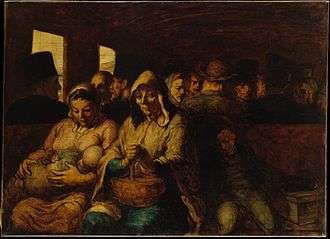 Honoré Daumier, The Third-Class Carriage, 1863–65.
Honoré Daumier, The Third-Class Carriage, 1863–65. Odilon Redon, The Raven, 1882.
Odilon Redon, The Raven, 1882..jpg) Paul Gauguin, The Quarries of Le Chou near Pontoise, 1882.
Paul Gauguin, The Quarries of Le Chou near Pontoise, 1882. Vincent van Gogh, Iris, 1890.
Vincent van Gogh, Iris, 1890.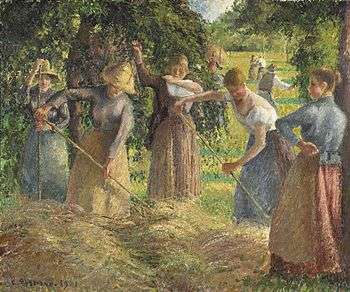
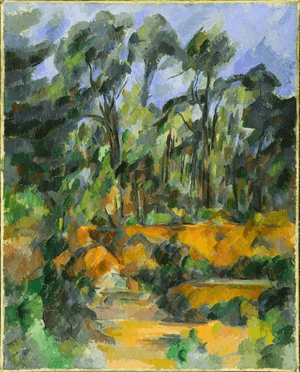 Paul Cézanne, Forest, c. 1902–04.
Paul Cézanne, Forest, c. 1902–04.
20th century
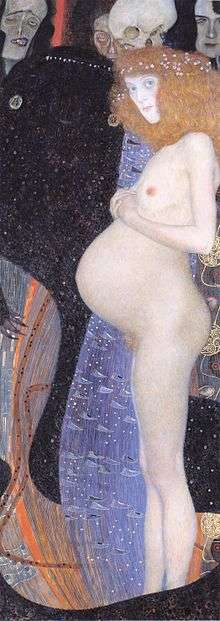 Gustav Klimt, Hope I, 1903.
Gustav Klimt, Hope I, 1903.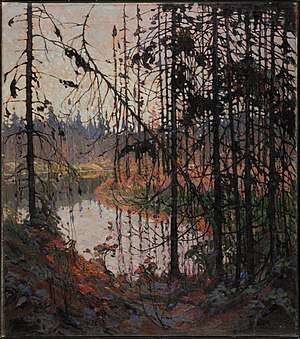 Tom Thomson, Northern River, 1914–15
Tom Thomson, Northern River, 1914–15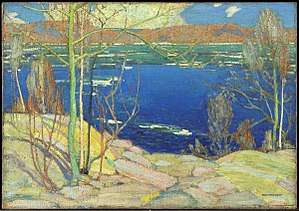 Tom Thomson, Spring Ice, 1915–16
Tom Thomson, Spring Ice, 1915–16 Tom Thomson, The Jack Pine, 1916–17.
Tom Thomson, The Jack Pine, 1916–17.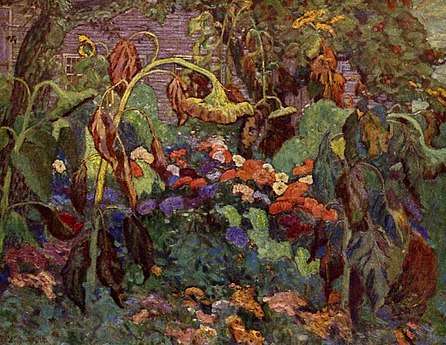 J. E. H. MacDonald, The Tangled Garden, 1916
J. E. H. MacDonald, The Tangled Garden, 1916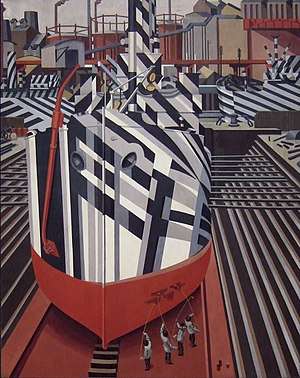
 David Milne, Vimy Ridge from Souchez, Estaminet among the Ruins, 1919.
David Milne, Vimy Ridge from Souchez, Estaminet among the Ruins, 1919. Franklin Carmichael, The Upper Ottawa, near Mattawa, 1924.
Franklin Carmichael, The Upper Ottawa, near Mattawa, 1924. Bill Vazan, Black Nest, 1989–91.
Bill Vazan, Black Nest, 1989–91.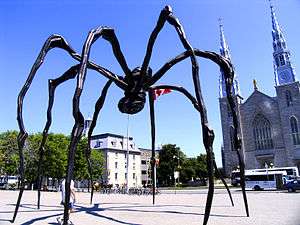 Louise Bourgeois, Maman, 1999.
Louise Bourgeois, Maman, 1999.
- Auguste Rodin, Age of Bronze, 1875–1876, cast in 1901.
- M. C. Escher, Stars, 1948.
- Barnett Newman, Voice of Fire, 1967.
Affiliations
The Museum is affiliated with: CMA, Ontario Association of Art Galleries, CHIN, and Virtual Museum of Canada.
References
- ↑ The Canadian Encyclopedia Archived 2009-02-13 at the Wayback Machine.
- 1 2 3 National Gallery of Canada – 1980 Archived 2010-09-19 at the Wayback Machine.
- ↑ "Concordia university to award five honorary degrees at five ceremonies for 3300 graduating students". Concordia University.
- ↑ "Mayer confirmed as gallery director" Archived 2008-12-15 at the Wayback Machine., The Globe and Mail, 8 December 2008.
- 1 2 Pound, Richard W. (2005). 'Fitzhenry and Whiteside Book of Canadian Facts and Dates'. Fitzhenry and Whiteside.
- ↑ Cook, Marcia (11 May 2000). "Cultural consequence". Ottawa Citizen. Canwest. Archived from the original on 30 May 2010. Retrieved 2009-10-11.
- ↑ National Gallery of Canada: Contemporary Art Archived 2007-08-16 at the Wayback Machine.
- ↑ National Gallery acquires rare Renaissance masterpiece by Salviati Archived 2007-07-14 at the Wayback Machine., 15 August 2005
- ↑ National Gallery of Canada is latest major museum to welcome Louise Bourgeois' Maman Archived 2009-09-25 at the Wayback Machine., 9 May 2005
- ↑ National Gallery of Canada: Canadian & Aboriginal Art Archived 2007-08-18 at the Wayback Machine.
- ↑ National Gallery of Canada: Past Exhibitions Archived 2007-08-19 at the Wayback Machine.
- ↑ National Gallery of Canada: Travelling Exhibitions Archived 2007-08-18 at the Wayback Machine.
Further reading
- Ord, Douglas (2003), The National Gallery of Canada: ideas, art, architecture, McGill-Queen's University Press, ISBN 0-7735-2509-2
- Robert Fulford, "Turning the absurd into an art form: Canada's National Gallery has a history filled with bizarre decisions," National Post, 9 September 2003, http://www.robertfulford.com/2003-09-09-gallery.html
External links
| Wikimedia Commons has media related to National Gallery of Canada. |